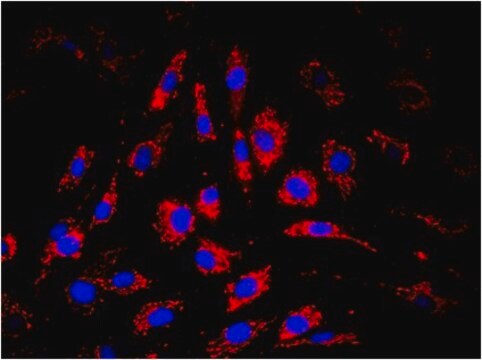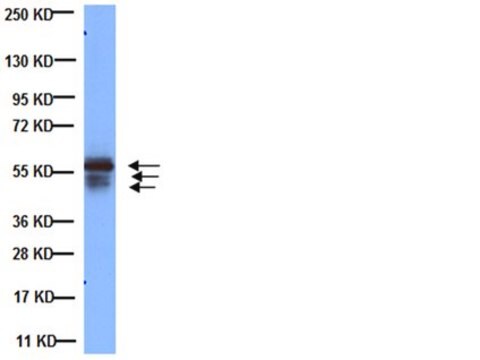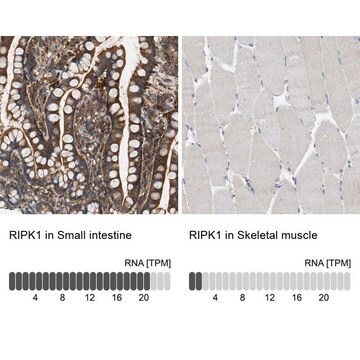MABN2635
Anti-Mitochondrial ferritin/FTMT Antibody, clone C65-2
About This Item
Polecane produkty
pochodzenie biologiczne
mouse
Poziom jakości
białko sprzężone
unconjugated
forma przeciwciała
purified antibody
rodzaj przeciwciała
primary antibodies, primary antibodies
klon
C65-2, monoclonal
masa cząsteczkowa
calculated mol wt 27.54 kDa
observed mol wt ~29 kDa
oczyszczone przez
using protein G
reaktywność gatunkowa
human, monkey
opakowanie
antibody small pack of 100 μg
metody
immunofluorescence: suitable
immunohistochemistry (formalin-fixed, paraffin-embedded sections): suitable
western blot: suitable
izotyp
IgMκ
sekwencja epitopowa
C-terminal
numer dostępu Protein ID
numer dostępu UniProt
Warunki transportu
ambient
docelowa modyfikacja potranslacyjna
unmodified
informacje o genach
human ... FTMT(94033)
Powiązane kategorie
Opis ogólny
Specyficzność
Immunogen
Zastosowanie
Evaluated by Western Blotting in lysates from HEK293 cells overexpressing Ferritin mitochondrial (FTMT).
Western Blotting Analysis (WB): A 1:250 dilution of this antibody detected Ferritin, mitochondrial (FTMT) in lysate from HEK293 cells overexpressing FTMT.
Tested Applications
Immunohistochemistry Applications: A representative lot detected Mitochondrial ferritin/FTMT in Immunohistochemistry applications (Yang, M., et al. (2017). Acta Histochem Cytochem. 50(1):49-55).
Western Blotting Analysis: A representative lot detected Mitochondrial ferritin/FTMT in Western Blotting applications (Yang, M., et al. (2017). Acta Histochem Cytochem. 50(1):49-55).
Immunofluorescence Analysis: A representative lot detected Mitochondrial ferritin/FTMT in Immunofluorescence applications (Yang, M., et al. (2017). Acta Histochem Cytochem. 50(1):49-55).
Note: Actual optimal working dilutions must be determined by end user as specimens, and experimental conditions may vary with the end user
Postać fizyczna
Przechowywanie i stabilność
Inne uwagi
Oświadczenie o zrzeczeniu się odpowiedzialności
Kod klasy składowania
12 - Non Combustible Liquids
Klasa zagrożenia wodnego (WGK)
WGK 1
Temperatura zapłonu (°F)
Not applicable
Temperatura zapłonu (°C)
Not applicable
Certyfikaty analizy (CoA)
Poszukaj Certyfikaty analizy (CoA), wpisując numer partii/serii produktów. Numery serii i partii można znaleźć na etykiecie produktu po słowach „seria” lub „partia”.
Masz już ten produkt?
Dokumenty związane z niedawno zakupionymi produktami zostały zamieszczone w Bibliotece dokumentów.
Nasz zespół naukowców ma doświadczenie we wszystkich obszarach badań, w tym w naukach przyrodniczych, materiałoznawstwie, syntezie chemicznej, chromatografii, analityce i wielu innych dziedzinach.
Skontaktuj się z zespołem ds. pomocy technicznej







